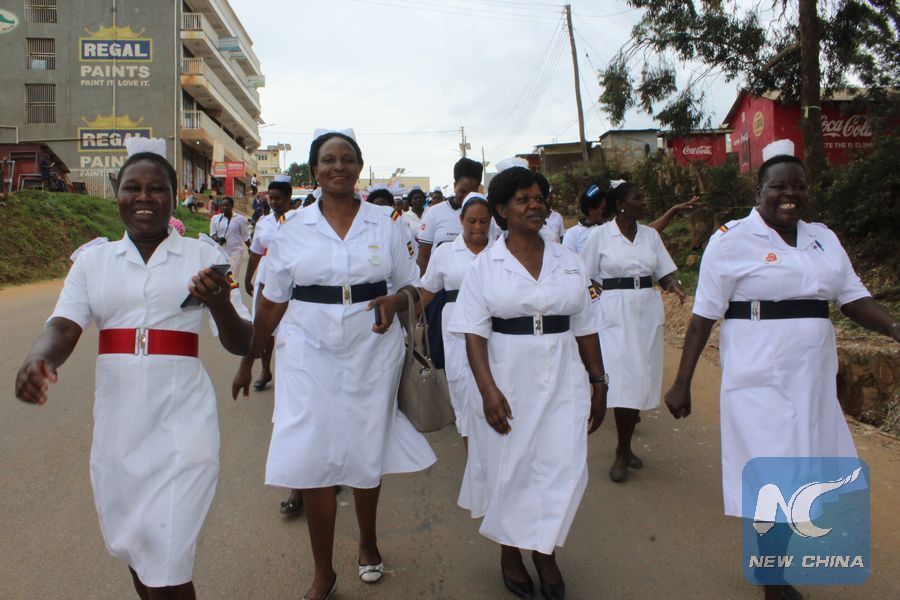
Midwives in Uganda march during the commemoration of the International Day of the Midwives in Mbarara district, Uganda, May 5, 2019. Uganda on Sunday joined the rest of the world to commemorate the International Midwives' Day. (Xinhua/Geoffrey Mutegeki)
by Ronald Ssekandi
MBARARA, Uganda, May 6 (Xinhua) -- Forty seven-year-old Trifonia Atukunda is living her dream. Since childhood, Atukunda always wanted to be a midwife and now she is one; practicing here at Bwizibwera Health Center IV in the western Ugandan district of Mbarara.
As the world commemorates the International Midwives' Day on Sunday, it is people like Atukunda that are being celebrated for helping mothers deliver babies safely.
"I like midwifery because I love babies, when a mother delivers, I feel happy," Atukunda told Xinhua in an interview on Sunday.
Midwifery can be mentally, emotionally and physically draining especially in a country like Uganda where there are few midwifes compared to the increasing number of mothers giving birth in hospitals.
According to the United Nations Population Fund (UNFPA), Uganda faces a national gap in midwifery staffing positions of about 36 percent.
Midwifes, especially in remote areas where the service is limited, work under immense pressure.
Atukunda's shift starts with a handover brief from an exhausted colleague. This involves a full run-down of each new mother, what kind of birth they had and what needs to be done for them that day.
A memorable experience in Atukunda's 15 year career is when she helped seven mothers deliver in one night.
She said on that day about three years ago, most of the mothers came in when they are in the second stage of labor.
She lined them up, each on her bed, and whoever called on her was assisted to deliver.
"I delivered seven of them and the eighth one after delivery we immediately referred because she developed complications," Atukunda said, noting that she had to call for assistance from her colleague who was off duty.
Atukunda rarely takes breaks because if she does, the number of mothers from the labor ward keeps increasing.
This however comes at the expense of the new mothers because they don't get enough care as needed.
Some mothers have to be discharged before time because space has to be created for others who are in a more critical condition.
At the end of her 12-hour shift, Atukunda is tired and simply wants to go and rest at her house, a few meters away from the maternity ward.
Sometimes it is not a guarantee that she will rest because she is on call, just in case her colleague on the shift is overwhelmed.
Ministry of health figures show that in Uganda, a midwife conducts between 350 and 500 deliveries per year; more than twice the 175 deliveries as recommend by World Health Organization.
RAY OF HOPE
According to UNFPA, midwives, supported by a functional health system, can avert up to 87 percent of all maternal and newborn deaths.
Despite the staffing shortage, ministry of health figures show a positive trend of an increase in the number of women who deliver with assistance from a skilled provider, usually a midwife.
About seven out of 10 women (74 percent) now deliver with assistance from a skilled birth attendant compared to 5 out of 10 women (58 percent) in 2011 and 4 out of 10 women (42 percent) in 2006.
The 2016 Uganda Demographic Health Survey shows that maternal mortality ratio has reduced by 24 percent from 438 to 336 per 100,000 live births.
There are both government and private efforts to increase the number of nursing and midwifery training institutes in the country.
Miranda Tabifor, deputy representative of UNFPA said at the commemoration event that midwifery education and training is important in improving standards.
Tabifor said with support from the Swedish government, since 2010, a total of 590 midwives have benefited from the Midwifery Training Bursary and Bonding Program. Over 450 have completed training, of which 306, about 68 percent, have been deployed across the country.
"This has been one of the strategic interventions to address the midwifery deficit, especially in hard-to-reach areas like the Karamoja region," she said.
Karamoja region is in semi-arid northeastern Uganda.
Joyce Moriku Kaducu, minister of state for health in charge of primary health care said government is making plans of recruiting more midwives to increase the staffing levels.
She urged the midwives to go for further training in order to build their capacity.
The minister said that the government recently gave the midwives a salary enhancement to motivate them to work harder.

